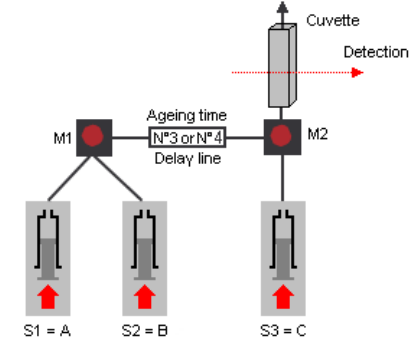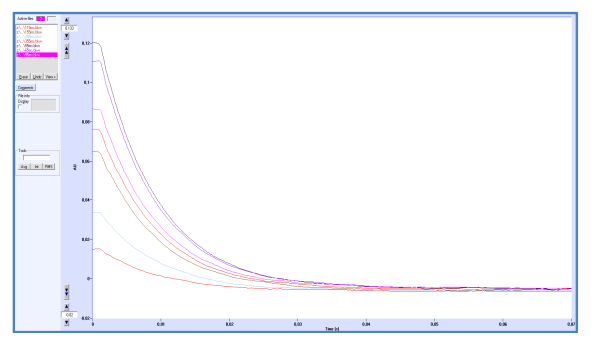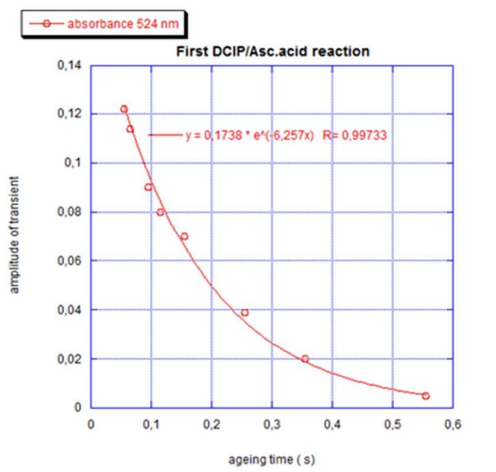Double mixing stopped-flow using interrupted flow method – SFM-2000 seriesRapid kinetics – Application Note 21
Latest updated: March 1, 2023Abstract Often, in kinetic analyses two reactants must be mixed then aged before mixing with a third reactant. The SFM-3000 and SFM-4000 are the ideal systems for these types of double mixing experiments, taking full advantage of the precision of independent stepping motors. This application note illustrates the capabilities of the SFM 3000/4000 to mix reagents with variable aging times using the reduction of dichloroindophenol by ascorbic acid. No hardware reconfiguration is necessary because of the independent stepping motors are controlled by the software automatically, making the SFM instruments unique. All the user needs to do is define the mixing sequence and collect the data.
To view the entire application note please click the download button below.
Introduction
SFM-3000 and SFM-4000 are the ideal systems for double mixing experiments taking full advantage of the precision of independent stepping motors. Users can easily design a series of injections at different ageing times so reaction intermediates not visible with single mixing methods become observable.  Figure 1 : Double mixing set-up. In a double mixing experiment, two reactants are mixed in mixer 1 (M1) and are allowed to age during an user-defined ageing time. After initial ageing, content of the delay line is mixed with a third reactant in mixer 2 (M2), and this second reaction can be observed using an optical method. Depending on ageing time, the mixing is done in continuous flow mode or in interrupted flow mode, covering ageing time range from 2 ms to several minutes.
Figure 1 : Double mixing set-up. In a double mixing experiment, two reactants are mixed in mixer 1 (M1) and are allowed to age during an user-defined ageing time. After initial ageing, content of the delay line is mixed with a third reactant in mixer 2 (M2), and this second reaction can be observed using an optical method. Depending on ageing time, the mixing is done in continuous flow mode or in interrupted flow mode, covering ageing time range from 2 ms to several minutes.
Experiment
To illustrate double mixing the standard DCIP/ascorbic acid reaction can be used. In mixer 1 dichloro-indophenol (DCIP) is mixed with a low concentration of ascorbic acid (0.5 mM), the mixing is allowed to age for a defined time in a 120 µl delay line before it is mixed with a higher concentration of ascorbic acid (5 mM). This second reaction is followed in absorbance mode using a TC-100/10 cuvette (1 cm light path).  Figure 2 : Transients obtained varying ageing time from 55 ms to 600 ms Total flow rate is kept constant for all ageing times. Transients are recorded with ageing times from 55 ms to 600 ms, as shown in Figure 2. Each transient is fitted with a single exponential so its amplitude is measured and users can check whether the observed rate constant is constant or not. As dead time is constant, plotting the amplitude of the transient species versus time will show the first reaction and the rate constant of first reaction can be defined.
Figure 2 : Transients obtained varying ageing time from 55 ms to 600 ms Total flow rate is kept constant for all ageing times. Transients are recorded with ageing times from 55 ms to 600 ms, as shown in Figure 2. Each transient is fitted with a single exponential so its amplitude is measured and users can check whether the observed rate constant is constant or not. As dead time is constant, plotting the amplitude of the transient species versus time will show the first reaction and the rate constant of first reaction can be defined.  Figure 3 : Determining rate of first reaction Plotting the amplitude of transient versus ageing time is well fitted with a single exponential, and the first reaction rate calculated is 6.2 s-1.
Figure 3 : Determining rate of first reaction Plotting the amplitude of transient versus ageing time is well fitted with a single exponential, and the first reaction rate calculated is 6.2 s-1.
To check if measurements are correct, users can mix DCIP and ascorbic acid (0.5 mM) from corresponding syringes making sure enough volume is pushed to fill both delay line and cuvette.  Figure 4 : First mixing step The first mixing step is fitted with a single exponential and gives a rate constant of 5.9 s-1, in good agreement with rate constant determined in the double mixing mode. This demonstrates the performance of our SFM mixers.
Figure 4 : First mixing step The first mixing step is fitted with a single exponential and gives a rate constant of 5.9 s-1, in good agreement with rate constant determined in the double mixing mode. This demonstrates the performance of our SFM mixers.
Automation
Independent stepping motors offer extended capabilities to run series of experiments automatically. This makes BioLogic’s SFM instrument unique on the market.  Figure 5 : Double mixing automatic mode Users simply need to define a global mixing sequence according to delay line installed, cuvette in the observation head, and mixing ratio applied, then they just edit a list of ageing times they want to perform. The software will automatically run the full series and the user just needs to collect data.
Figure 5 : Double mixing automatic mode Users simply need to define a global mixing sequence according to delay line installed, cuvette in the observation head, and mixing ratio applied, then they just edit a list of ageing times they want to perform. The software will automatically run the full series and the user just needs to collect data.




